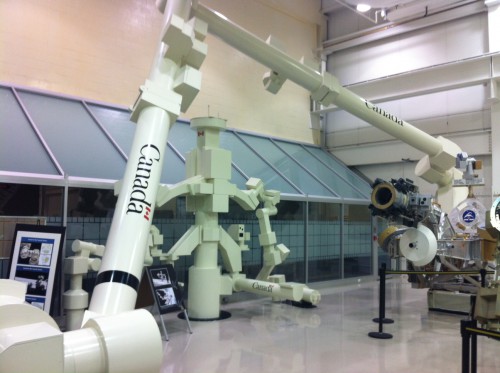11th December 2014 Montreal, Canada
Looking up : Canada and the UK on route to the stars !
I am not taking credits for this wonderful blog – only for my limited driving skills to the Canadian Space Agency and as photographer. This blog was written by my new colleague and blogger Anne Cécile Dequen CG’s assistant and trade associate in Montreal.

Conquering space is more valid today than ever. Indeed, space represents a fertile ground to better understand the world around us, to monitor our environment, to protect our natural habitat, and to exceed our own limitations in matters of innovation. In addition to actively contributing to scientific research through its partnership with the International Space Station (ISS), Canada is a leader in the field of sophisticated robotics.
In light of this impressive resume, and after several discussions between the Canadian Space Agency and the British Consulate-General in Montreal regarding potential collaborations, a meeting in person was the obvious next step. It was therefore with great pleasure that UK’s SIN officer Mario Rivero-Huguet and I were invited to roam the corridors of this imposing building that houses some of Canada’s biggest space research accomplishments.
Inside the Agency, history is everywhere. You just have to follow the timeline up on the walls to understand the abundance of major events, just like the launch of Anik A1 in 1972 which established Canada as the first country to possess a Satellite Communications System. The journey continues with the presentation of life-sized models that both impress and fascinate (I will let you witness it for yourself by looking at the photograph below featuring the famous Canadarm2).

This 17-metre long robotic arm, referred to as the «handyman» is used to assemble and move orbital components (supplies, equipment and even astronauts!) in order to dock them to the ISS, is clearly a source of pride for Canada. Other successes include Dextre, RADARSAT-1 and RADARSAT-2.
No need to convince you of the relevance of our visit. Our smiles on our faces and the stars in our eyes at the look of all those highly sophisticated tools were proof enough, but we also got the chance to meet future partners and to pursue our discussions on potential projects. These projects would mainly focus on environmental monitoring, agricultural mapping, and the research programme on ageing in space. This interesting programme aims to study the health consequences related to spaceflights and to have those conclusions help with our own understanding of ageing here on earth.
Still today, space rhymes with the unknown. Many secrets remain, but the Canadian Space Agency and its international partners have worked at illuminating some fragments of this mysterious universe, rendering this complex reality more comprehensible and tangible.